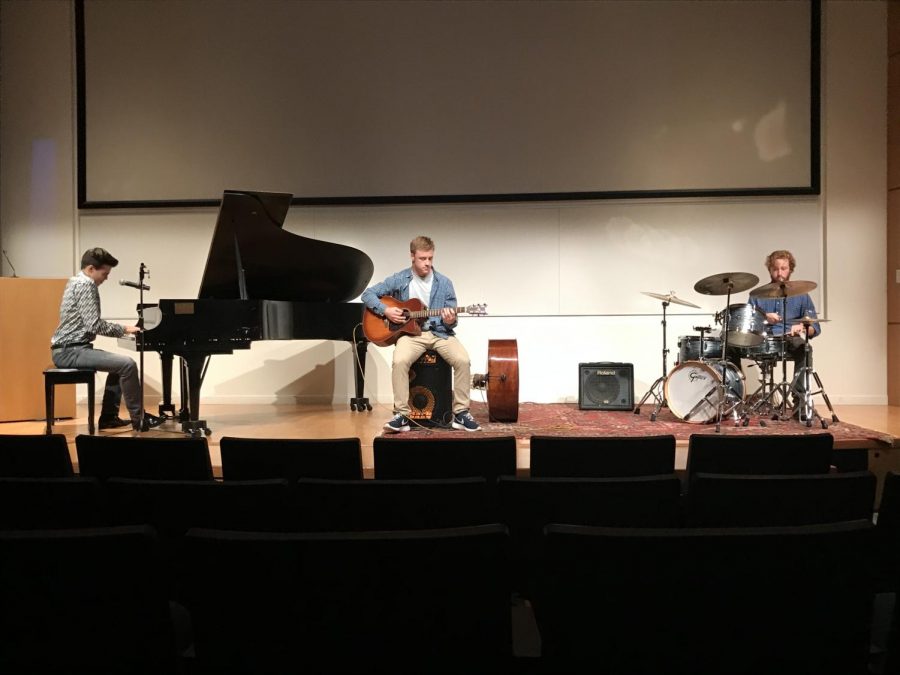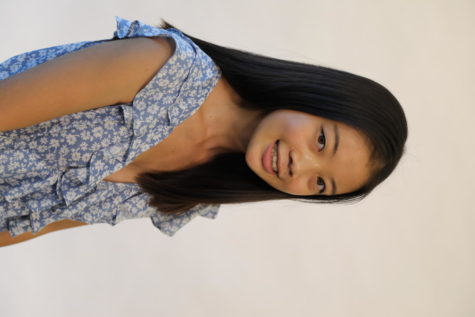Despite Greater STEM Growth, Menlo Humanities Also Expanding
Senior Adam Kasser, junior Leo Jergovic and senior Aaron Morgan present their IP project, a major addition to the humanities department. Staff photo: Bella Guel.
December 4, 2019
Opportunities in both STEM and humanities at Menlo have expanded and evolved over the past couple of decades in response to changing interests among the student body. A committee for deciding course options has noticed and reacted to an increasing demand in Menlo’s STEM classes by growing the STEM departments, but the committee has broadened its offerings in humanities-focused subjects as well.
The curriculum committee for the Upper School consists of Upper School Director John Schafer, Head of School Than Healy, each of the department chairs, and the college counselors. The committee discusses and makes major decisions surrounding changes to the course catalogue.
New Opportunities in STEM
The main motivation for adding more STEM classes recently has been their growing popularity, according to Schafer. “The students are voting with their feet for more STEM classes. To a large extent, we’re able to meet that demand,” he said. In the past decade, students have expressed a desire for more options in the STEM department, so Menlo has added new courses and electives including Design and Architecture, Sustainable Earth Engineering and Experimental Archaeology.
This rise in STEM classes has not only been prompted by increasing interest, but also by an objective to evolve the department along with modern times, according to Science Department Chair James Formato.
“We offer a really robust college prep experience for Menlo students, and we’re teaching classes and content that has meaning in the lives of Menlo students,” Formato said.
Formato also believes that the Whitaker lab provides unique opportunities in STEM of which students should take advantage. This year, a Whitaker component has been added to the Freshman Rotation program in order to encourage a wider and more diverse range of students to embrace the courses and equipment in Whitaker.
The Applied Science Research (ASR) course, which Menlo introduced to the course catalog in the 2007-2008 school year, is a student-driven science and engineering class. Many students have taken it to pursue more individualized STEM paths. In ASR, students create and build various projects that they are particularly interested in, as well as bigger class projects — including their well-known weather balloons.
More Humanities Options, Too
Along with this growth in the STEM department, the school has also devoted many resources to expanding the humanities as well. According to Schafer, the two categories grow independently for the most part, and efforts to enhance STEM do not deduct from the arts and humanities budget.
Like the ASR course in the STEM department, Menlo has added the Interdisciplinary and Personalized Scholars Program (IP) for students who want to create their own projects in a more humanities-based environment. Healy and Schafer are among those who have worked on developing the program over the past five years, according to history teacher Katharine Hanson, who teaches the IP Capstone class.
During the 2017-2018 school year, then-senior Ari Troper (‘18) wrote, produced and staged his own musical, recruiting several Menlo students to participate in his project as actors, according to Schafer. The idea for the IP program had been several years in developing when Troper created this project and earned the first honorary IP designation, Schafer said.
According to Hanson, the IP program is open to STEM-based projects as well as humanities-based projects. However, Menlo’s extensive STEM selection, especially ASR and Biotechnology Research, already allows students to pursue many of their STEM interests. “We believe we kind of already have this […] individual independent study approach over in the sciences and engineering,” Schafer said. As a result, most of the IP projects that students propose are humanities-based.
Senior Nico Monsalve worked on an IP last year, creating an application on the Amazon Alexa program that analyzes and improves questions that students ask. The project’s purpose was to help students develop critical thinking and creativity skills.
Monsalve’s project was unlike many other students’ IPs in that it was more STEM-based, but he did not find this aspect to be a drawback in getting the project approved. “It was a little difficult because the [IP] class was based around non-STEM-focused projects. But [Hanson] adapted the course really well, and the course is pretty open-ended to begin with,” he said.
In the IP program, a panel of three Menlo faculty members — each from a different department — judges and offers suggestions to each student’s individual project proposal. According to Schafer, this panel concept resembles the oral defense presentation structure that many PhD courses follow in order to promote the independence aspect of the IP program.
Monsalve found this panel of faculty members to be encouraging and helpful rather than an obstacle to getting his STEM project approved. “As long as you have a project that you’re very passionate about, the teachers will also be very passionate about it,” he said.
The IP program is still a work in progress, according to Hanson. “I do think the whole community could benefit from greater clarity on the program,” she said. The class enrollment this fall semester has significantly increased from last year’s approximately 12 students to 21 students, and Hanson hopes that there will be more data on how to continue to improve the IP program by the end of the semester.
History Department Chair Carmen Borbón appreciates that the IP program allows students to branch out more in the humanities. “I think, sometimes, kids feel like they don’t like the humanities because they feel restricted in the choices that they have. But I think the IP allows kids to really kind of focus on their passion,” she said.
“Given that we’re in Silicon Valley, it’s sort of like you’re encouraged to go into STEM,” Borbón said. “But at the same time, the humanities allow you to empathize and think in ways that help you solve problems that maybe you wouldn’t think about if you’re just a STEM person.”
In addition to adding the IP Capstone class last year, three years ago, the history department and Menlo administration also made the decision to include honors options for every history elective, Borbón said. This change allows students to pursue higher-level learning in various history courses that they are particularly interested in. While Borbón hopes that students take advantage of these new opportunities, she also does not want students to be overloading themselves with too many honors classes. The history department typically does not allow students to take two history honors classes at the same time, according to Borbón.
What This Means For Students
While the demand for STEM classes has increased recently, new expansions of the humanities — including the IP and history honors options — show that the humanities department certainly has not been forgotten or left behind. “I know people say that Menlo prioritizes STEM kids and STEM classes,” senior Eavan Murray said. “But I think that especially over the last few years, when they sort of revamped the history curriculum and all the electives and everything, it’s easy if you’re a humanities person to find a ton of opportunities to explore that.”
“I would say when I was a freshman and sophomore, [Menlo] was definitely very [STEM-oriented], […] but now there are so many history electives to choose from, and I feel like it’s much more well-rounded,” senior Charlotte Tomkinson said. Tomkinson enjoys both STEM and humanities but considers herself to be more of a humanities-oriented student.
Although many students choose to take more STEM classes, Menlo continues to provide a variety of classes to suit the preferences of every student. “The school has that consistent goal of finding ways for students to be acknowledged and to find something they love [that they can] go forward with,” Upper School Registrar Dr. Julie Hammack, who organizes student schedules each year, said.
Menlo also began construction for a new Spieker Center for the Performing Arts in April 2019, and it is projected to be finished by August 2020, according to Director of Communications Alex Perez. This building will enhance the arts programs and further expand the range of opportunities offered for arts and humanities-oriented students.
“I’m really excited for the Performing Arts Center. […] I think that’ll help draw attention [to the humanities],” Borbón said. “And [students will] also see that you can do both. You don’t have to just do STEM, and you don’t have to just do humanities.”
According to Dr. Hammack, many students have started to branch out from devoting nearly all of their efforts to either STEM or the humanities. “I think students are beginning to realize that they can meld [STEM and humanities] together,” she said.
While this change in attitude has resulted in students exploring a wider array of subjects, it has also led to many students taking on too many advanced classes and overburdening themselves. Murray struggled with this problem last year, but she was ultimately able to balance all her classes well. “When I was choosing my classes last year, I kind of struggled to compile my schedule to allow myself to have both [STEM and humanities classes],” she said. “And I think I did a good job of that, and I’m happy I did.”
“We can’t blame [students] for taking all these classes—we offer the classes. But I’m just trying to help them have a life of balance,” Schafer said. He hopes that students find a way to simultaneously take as many courses that interest them as possible while still getting a healthy amount of sleep and rest, like Murray was able to.
“I think the hardest thing [students] learn in high school is how to balance and make choices. It’s very difficult when you have so many things to choose from,” Dr. Hammack said. In this way, Menlo’s expansive curriculum prepares students for decision-making in college and beyond.
One of the biggest downsides of offering such a variety of courses is that some students take difficult classes primarily for the credit, according to Dr. Hammack. “I hate to say this—I think some course choices are based on what students believe colleges want,” she said.
“Our challenge is to make the argument to [students] that they should leave as a well-rounded student with a wide range of skills, […] but we don’t put a lot of rules around that because we do want to give students choice,” Schafer said.



